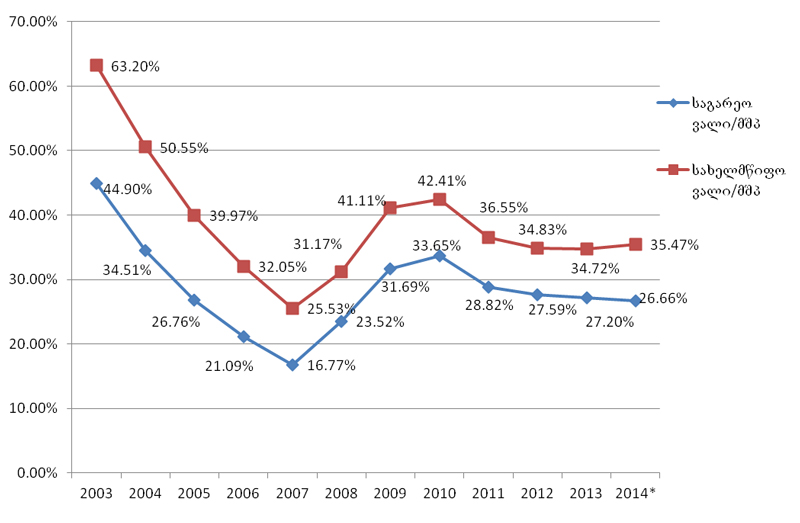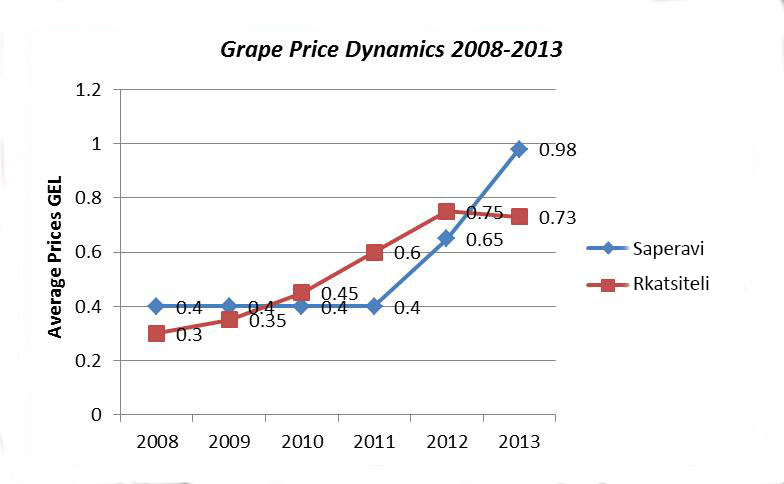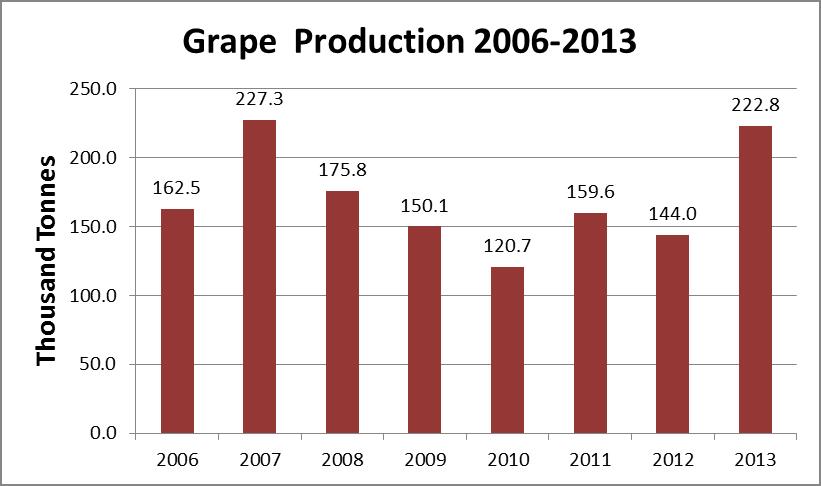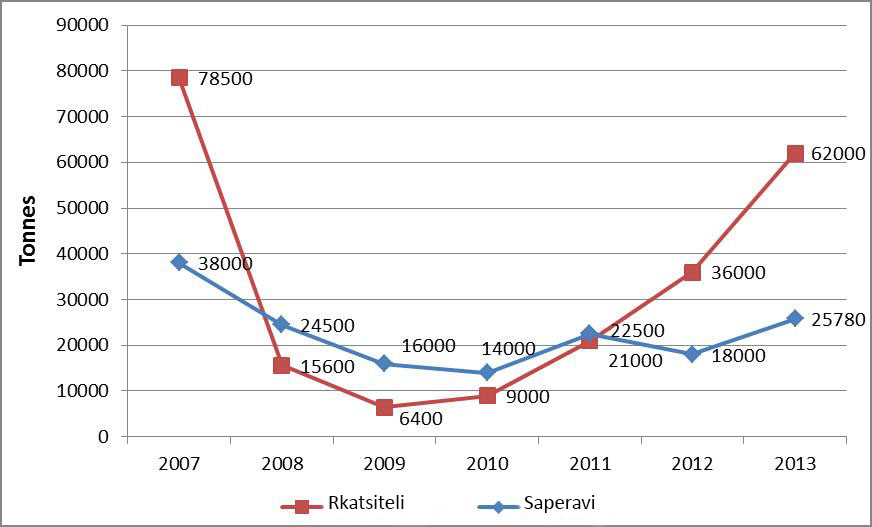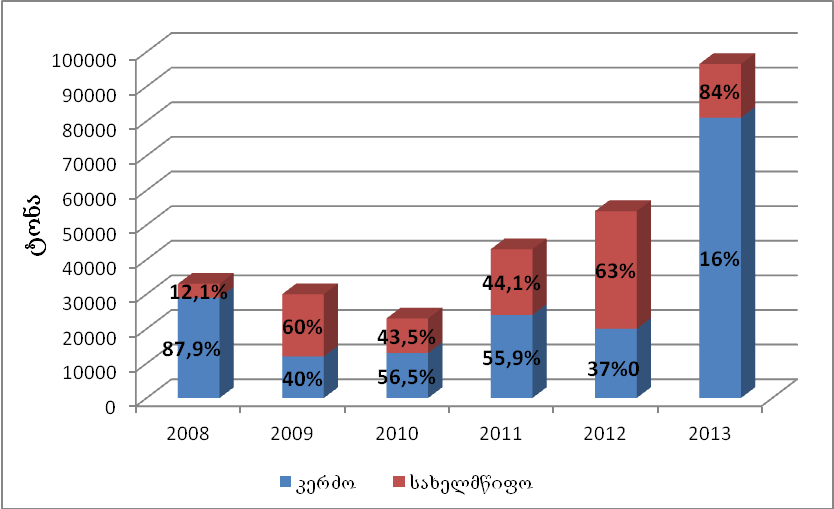On 9 July 2014, the then Minister of Agriculture of Georgia, Shalva Pipia, announced that Saperavi grapes would not be subsidised in 2014. He said that the reason for this decision was the increased demand on Saperavi. Even though Mr Pipia left office soon after this statement, given the importance of the issue FactCheck decided to publish the article.
Later, the new Minister of Agriculture, Otar Danelia, also talked about the decrease in subsidies for Saperavi grapes. He stated that subsidies for Saperavi would decrease from 25 to 15 tetri and for Rkatsiteli from 40 to 35 tetri.
In both of the aforementioned cases the reason for the termination or reduction of the subsidies was the increased demand on Saperavi which would ensure the maintenance of the prices and, therefore, cutting or terminating the subsidies would not have a negative effect upon the income of the farmers.
Despite the fact that according to the decision of the new Minister of Agriculture the grape harvest of 2014 will be subsidised, the subsidies will be reduced for both varieties. In addition, according to the statement of the Ministry of Agriculture, the positive trends in the field ensure that no subsidies will be necessary in the future.
FactCheck took interest in the conditions of the Georgian wine industry and viticulture and analysed the possibility of the development of this field without subsidies.
The subsidisation of the vintages started in 2008 by government initiative. The main goal of the project was to neutralise the negative effects of the Russian embargo and facilitate the development of the Georgian wine industry and viticulture. From 2009 to today, positive tendencies in this field are apparent; namely, the export of wine has grown since 2009. According to the data of the National Statistics Office of Georgia, the amount of exported wine was equal to 35.9 million litres which is 375% more than that of 2009. The income from wine export amounted to USD 129.5 million which is almost twice as much (195.2%) as it was in 2012 and almost four times as much (399.6%) as in 2009. The chart below depicts the wine export dynamics from 2009 to 2013.
Chart 1: Wine Export from 2009 to 2013
Source: National Statistics Office
As is clear from the chart, apart from the growth of wine export, the income from export also grew which indicates the growth of Georgian wine prices on foreign markets. According to these data, the average price of one litre of wine was USD 3.57 in 2009, varying from USD 3.28 to USD 3.40 for the next three years and reaching USD 3.61 in 2013 which was 10% more than that of the previous year. It should also be pointed out that the growth of prices followed the growth of the amount of exported wine which indicates the growing demands on Georgian wine on foreign markets. This is mainly due to the re-opening of the Russian market.
The high demand on wine resulted in the growing demand for and prices on grapes as well. According to the data of the Ministry of Agriculture, the price growth for Saperavi started in 2012. Before 2012, the average price for Saperavi (without subsidies) was equal to GEL 0.4 which increased to GEL 0.65 in 2012 and GEL 0.98 in 2013. The prices of Rkatsiteli also grew, the average price of which was GEL 0.3 in 2008 increasing to GEL 0.73 in 2013. The chart below depicts the dynamics of the prices of Saperavi and Rkatsiteli since 2008.
Chart 2: Average Price of Grapes from 2008 to 2013
Source: Ministry of Agriculture
As the chart makes clear, the prices of Saperavi had been on the rise since 2012 while the prices of Rkatsiteli had been increasing since 2008. The growth of prices indicates the high demand on a certain grape variety. Hence, the claim of the Minister of Agriculture that the demand on Saperavi has increased is true.
The production of grapes grew along with the growth of prices. The overall production of grapes amounted to 223 thousand tonnes which is 1.5 times more than that of the previous year. The chart below depicts the production of grapes since 2006. As the chart shows, the production of grapes is very close to that of 2007 when the subsidisation started. In addition, as we already pointed out earlier, the growth of production and prices of grapes indicates the growing demand.
Chart 3: Production of Grapes from 2006 to 2013
Source: National Statistics Office
As for the amount of processed grapes, the amount of processed Saperavi had an unstable dynamics while the amount of processed Rkatsiteli grew. The chart below depicts the dynamics of processed grapes since 2007.
Chart 4: Amount of Processed Grapes from 2007 to 2013
Source: Ministry of Agriculture
As we can see from the chart, the amount of processed grapes grew from 2009, reaching its peak in 2013 when the amount of processed Rkatsiteli almost doubled and the amount of processed Saperavi increased by 7,780 tonnes as compared to the previous year. However, none of these data could match the numbers of 2007.
As for the wine export, it almost doubled in 2013 as compared to the previous year; however, FactCheck was unable to determine the export of which types of wine had increased. If we compare the quarterly data it is clear that there has been a trend of export growth since 2012 and the trend holds in 2014 as well. According to the data of the Ministry of Agriculture, the amount of exported wine was 2.5 times more in the first quarter of 2014 and 65% more in the second quarter as compared to the respective quarters of the previous year. The table below reflects the amount of exported wine from 2012 to 2014.
Table 1: Quarterly Export of Wine from 2012 to 2014 (0.75 Litre Bottles)
Source: Ministry of Agriculture
It should also be noted that the share of the grapes processed by the private enterprises, as compared to state owned ones, is growing. The share of the grapes processed by the private enterprises constituted 84% of the overall amount in 2013. The growth of the amount of grapes processed by the private enterprises indicates the on-going positive changes and growing activities in the private sector. The chart below shows the share of private and state owned enterprises in grape processing.
Chart 5: Share of Private and State Owned Enterprises in Grape Processing from 2007 to 2013
Source: Ministry of Agriculture
Conclusion
The price of Saperavi doubled in 2013 as compared to 2009. The price of Rkatsiteli also grew and doubled as compared to 2007. The production of grapes also increased amounting to 222.8 thousand tonnes in 2013 which is 1.5 times more than that of 2012. The increase in the production and prices of grapes indicates the growth in demand as well. Another important factor is that the amount of the grapes processed by the state owned enterprises has significantly reduced in 2013. Private enterprises processed 84% of the overall amount of grapes in 2013 which indicates the growth in private sector activities. Export of wine has also increased. According to the data of the first two quarters of 2014, the amount of exported wine has doubled as compared to the same period of the previous year. Thus, we can conclude that the situation in the wine industry and viticulture has improved as compared to 2008.
Hence, the statement of the former Minister of Agriculture: “The demand on red grapes, Saperavi, in particular, is at least two times more than the expected harvest,” is TRUE.
|
|
2012 |
2013 |
Growth % 2012-2013 |
2014 |
Growth % 2013-2014 |
|
1st Quarter |
3,729,060
|
4,508,546
|
20.9% |
15,488,184
|
243.52% |
|
2nd Quarter |
5,452,155
|
6,877,989
|
26.15% |
11,383,961
|
65.51% |
|
3rd Quarter |
6,290,576
|
15,112,033
|
140.23% |
|
|
|
4th Quarter |
7,869,614
|
20,249,181
|
157.3% |
|
|


